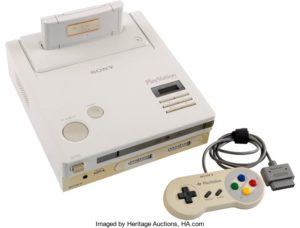 The failed collaboration between Nintendo and Sony to produce a CD-ROM add-on for the Super NES has become the stuff of legend. The details of the falling out have been documented pretty extensively over the years, and war stories from all the major players have appeared in both David Sheff’s Game Over and Blake Harris’s Console Wars.
The failed collaboration between Nintendo and Sony to produce a CD-ROM add-on for the Super NES has become the stuff of legend. The details of the falling out have been documented pretty extensively over the years, and war stories from all the major players have appeared in both David Sheff’s Game Over and Blake Harris’s Console Wars.
While we all know the story, what became of the small batch of prototype consoles produced by the two companies has always been a mystery. More than 200 Nintendo PlayStations were reportedly produced, and it’s assumed that most were destroyed, but one managed to escape the trash heap by hiding out in “a box of junk” previously owned by former Sony Computer Entertainment CEO Olaf Olafsson.
After his stint at Sony, Olafsson would take a job with Advanta Corporation, and this “box of junk” went with him, but when the financial company went bankrupt in 2009, the Nintendo PlayStation was left behind. It was found by Terry Diebold, who worked in Advanta’s maintenance department, and eventually made its way into the hands of his son, Dan.
Now, after game historians have examined and repaired the one-of-a-kind artifact, it’s going up for auction. The Diebolds are selling the prototype through Heritage Auctions, and as of this writing, the current bid is sitting at $145,000. And it’s unlikely to stop there, as proxy bids will continue to be taken until the start of the live auction on March 6.
So what will you get for your money? According to Heritage, the console features a fully-functioning Super Famicom cartridge slot:
We at Heritage can attest the prototype is working, as we’ve played a couple of rounds of Mortal Kombat on it using a Super Famicom cartridge.
The CD drive is also functional, but as no software was produced for the Nintendo PlayStation, all it can do is play music CDs:
Though the CD-ROM drive was not currently working when it was found in 2009, it has since been repaired by Benjamin Heckendorn, a YouTube personality known for his console repair videos. It now has the ability to play music CDs like the commercially produced PlayStation, but there is no proprietary software that’s known to have been made during the prototype’s development.
Heritage refers to the Nintendo PlayStation as “one of the most notorious, mysterious, and controversial artifacts of the video game industry” and it’s hard to argue with that.







